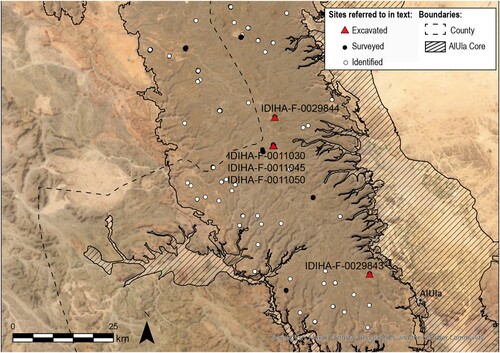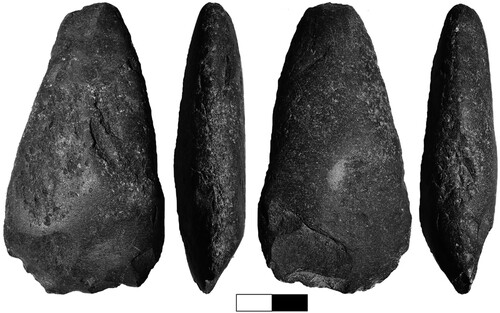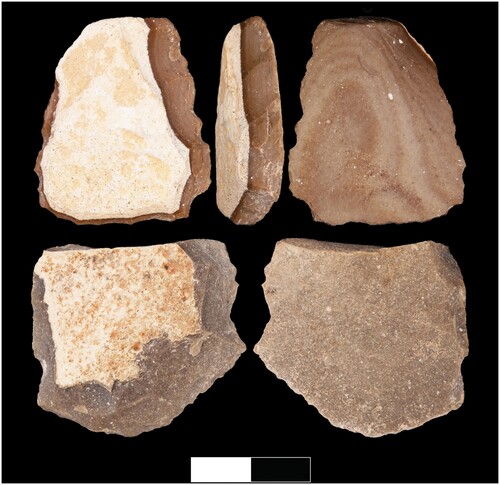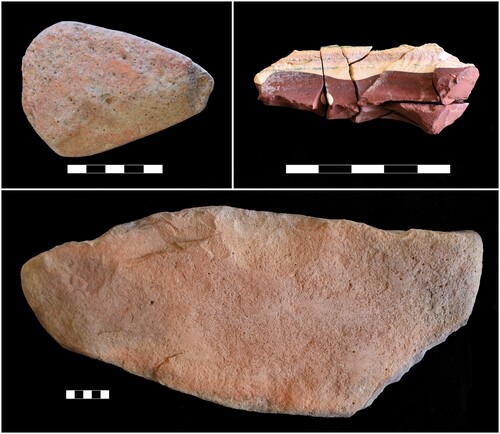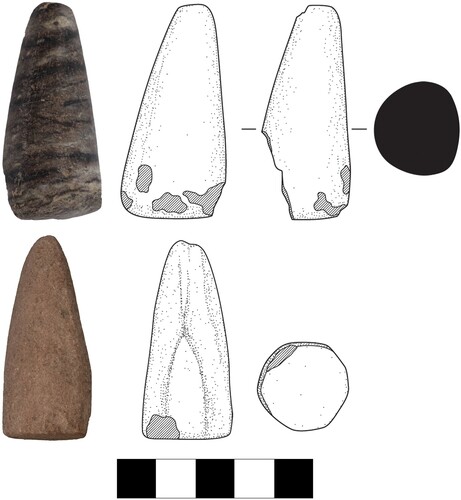Abstract
Recent archaeological investigations in AlUla County have provided the first detailed chrono-cultural evidence for long-term Neolithic domestic occupation in this archaeologically unknown region of north-west Arabia. This paper presents the preliminary findings drawn from multi-scalar datasets collected through extensive aerial and ground surveys, and the excavations of ‘monumental’ architectural installations, named in this study as ‘Standing Stone Circles’. These structures were individual dwellings, constructed in concentrations of varying numbers with associated domestic installations, such as hearths. The Standing Stone Cicle sites presented in this paper demonstrate a scale of Neolithic occupation not previously recognized in Saudi Arabia. These structures provide evidence of ongoing occupation throughout the 6th and 5th millennia BCE, concurrent with a general florescence of human activity across north-west Arabia. The faunal remains indicate a mixed subsistence economy, dominated by domesticates but supplemented by wild species. Broader considerations of the Neolithic economy, and models of pastoralism and mobility, are made possible on the basis of this, and the associated assemblages of stone artefacts and small finds. The data provided in this article offers a general picture of the Neolithic period in AlUla, addressing the significant geographical and temporal gaps within the archaeological knowledge of north-west Arabia. The identification of diagnostic Late Neolithic Levantine projectile point types, in conjunction with architectural parallels with the Levant, provides further insight into the origins of neolithization in north-west Arabia.
Keywords:
Introduction
The study of prehistoric occupation in north-west Saudi Arabia is currently the focus of increased archaeological investigation. A growing number of archaeological studies have begun to build upon the preliminary studies undertaken by the comprehensive survey programme of the 1970s (Adams et al. Citation1977; Gilmore et al. Citation1982; Ingraham et al. Citation1981; Parr et al. Citation1978; Zarins Citation1979). These studies identified a few Neolithic sites based on surface lithic assemblages (Inizan Citation2010; Parr et al. Citation1978; Purschwitz Citation2017). Within AlUla (العلا) County, the survey programme deliberately excluded the rugged terrain of a distinctive geological and geographical volcanic plateau known as the Harrat ‘Uwayrid (حرة عويرض (Gilmore et al. Citation1982; Ingraham et al. Citation1981)). This forms a transitional zone between the Hijaz Mountains and Nefud Desert, and it covers a sizeable proportion of the County ().
Figure 1 Satellite image of AlUla and Khaybar counties showing the location of the ḥarrah in north-west Arabia.
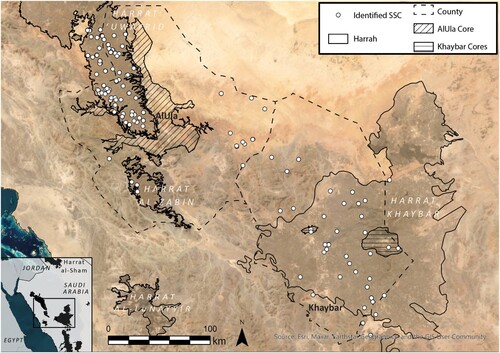
Prior to 2018, archaeological survey of the Harrat ‘Uwayrid had been limited. An unpublished survey, led by M. Sadig, in proximity to the asphalt road across the southern portion of the Harrat Uwayrid was conducted by King Saud University in 2014. This survey identified a series of prehistoric sites on the basis of lithic scatters and stone structures, however interpretations of date and function were limited. Nevertheless, the extensive archaeological remains that are visible across the surface represent a significant prehistoric landscape. Like elsewhere in Saudi Arabia, relative chronologies and regional comparisons indicate a prehistoric date for many of these structures. Firm identification and chronologies have been made possible with the increase in survey and test excavations across the region (Repper et al. Citation2022; Thomas et al. Citation2021a; Citation2021b). Due to the paucity of previous research, much of the available evidence has been interpreted through the frameworks of Neolithic models drawn from the more intensively studied areas of the Levant, focused on identification of imported and autochthonous elements in the local Neolithic cultures (Crassard and Khalidi Citation2017; Drechsler Citation2009; Groucutt and Petraglia Citation2012). Over the last 20 years, new archaeological and palaeoenvironmental data for the Neolithic in north-west Arabia have become available. Palaeoenvironmental evidence has elucidated the regional extent and duration of climate amelioration in the Early Holocene (Breeze et al. Citation2015; Dinies et al. Citation2015; Neugebauer et al. Citation2022). These findings, correlated with associated archaeological data, have provided a chronological, environmentally driven framework for investigating this marginal zone (Gebel Citation2019; Petraglia et al. Citation2020). Archaeological investigations have provided new evidence for the economic, technological and social dimensions of the Neolithic period (Guagnin et al. Citation2015; Citation2021; Munoz et al. Citation2020; Scerri et al. Citation2018). Widespread and distinctly homogenous cultic practices have been identified in the regionally unique Mustatil structures (Abu-Azizeh et al. Citation2023; Groucutt et al. Citation2020; Kennedy et al. Citation2023; Thomas et al. Citation2021a). Preliminary evidence for the prehistoric exploitation of domesticates has been excavated at hearth sites on the southern fringes of the Nefud (Guagnin et al. Citation2021; Scerri et al. Citation2018), and the introduction of herding by indigenous hunters has been inferred from the stratigraphic analysis of rock art (Guagnin et al. Citation2017). From these, more detailed discussions about the specific neolithization processes in the arid zones of northern Arabia are becoming possible.
This paper presents archaeological evidence from a class of domestic structures, termed ‘Standing Stone Circles’, recently identified across the Harrat ‘Uwayrid (). Excavations undertaken by the Aerial Archaeology in the Kingdom of Saudi Arabia (AAKSA) project, have revealed that they contain well-preserved and stratified occupational evidence dating to the 6th and 5th millennia BCE. This correlates broadly with the proposed timing for the consolidation of pastoralism in northern Arabia and the onset of the Neolithic elsewhere in the north-west (Guagnin et al. Citation2021; Scerri et al. Citation2018; Zielhofer et al. Citation2018). Whilst aerial survey and remote sensing have indicated a range of domestic architectural forms across the Harrat ‘Uwayrid, the Standing Stone Circles are distinguished by their distinctive construction technique that uses upright stone slabs. Data presented herein allow for the preliminary discussion of material culture, subsistence, regional mobility and cultural influences of the Neolithic in AlUla. Recognizing the localized but regionally connected character of this period, this study of Standing Stone Circle sites provides an unprecedented opportunity to gain insights into Neolithic cultural developments in AlUla, filling a significant lacuna in the archaeological literature of the Arabian Peninsula.
Project background
The AAKSA project consisted of several smaller projects related to the archaeology of the counties of AlUla and Khaybar (خَيْبَر). The multi-scalar approach of the project consisted of remote sensing, aerial photography, ground survey and targeted excavation. AAKSA formed part of the Identification and Documentation of Immovable Heritage Assets (IDIHA) project, sponsored by the Royal Commission of AlUla. From 2018–2022, the AAKSA project undertook documentation and analysis of the archaeological landscape of AlUla County’s hinterland in the Al Madinah Province of north-west Saudi Arabia — an area of c. 20,000 km2. A core zone was defined to encompass the areas of historical and modern occupation for intensive pedestrian survey and targeted excavation; this area was excluded from the AAKSA project study area. Fieldwork was also undertaken across a further 22,000 km2 of Khaybar County, to the south-east of AlUla, with a core zone defined around the oasis of Khaybar, also excluded from this study (). In order to address the methodological constraints faced in studying archaeological sites in remote landscapes, a combination of digital and traditional methods were employed (Thomas et al. Citation2022). This work has allowed for further quantification and description of new feature types (Thomas et al. Citation2021a; Citation2021b), including Standing Stone Circles, and has expanded the range of a number of others (Dalton et al. Citation2021; Repper et al. Citation2022).
Domestic architecture in AlUla
Previously identified architectural remains associated with the prehistoric occupation of north-west Arabia have consisted of multi-cellular ‘honeycomb’ clusters of irregularly shaped enclosures with low rubble walls, collectively identified as stone circles (Gilmore et al. Citation1982; Parr et al. Citation1978). These remains are consistent with the disambiguated ‘stone enclosure’ forms identified and attributed to the ‘late prehistoric’ in southern Jordan (cf. Abu-Azizeh Citation2014). The following typology was adopted by the IDIHA programme and forms the basis of feature descriptions in the AAKSA survey:
Simple enclosures: a single enclosed space;
Developed enclosures: two adjoining spaces; or
Complex enclosures: three or more adjoining spaces.
Figure 3 Examples of enclosure construction on the Harrat ‘Uwayrid. A–B: multi cellular ‘honeycomb’ clusters of irregularly-shaped abutting enclosures with rubble walls — individual cells measure anywhere from 2.5 m to 35 m; C–D: Standing Stone Circles with upright stone walls (single Standing Stone Circle examples pictured).
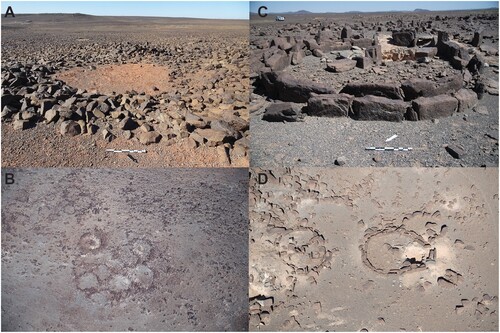
Single Standing Stone Circles
Single Standing Stone Circle forms consist of a small circular enclosure between 4 and 8 m in diameter, with a single standing stone positioned at the centre of the structure (A). To date, eight single Standing Stone Circle structures have been excavated across the Ḥarrat ‘Uwayrid (). The perimeter is composed of a single, or a double concentric, row of upright megalithic stone slabs, which are packed with smaller stones at the base to support them (B). Most structures have at least one doorway, formed by two upright stone slabs positioned perpendicular to the exterior walls (C). A stone threshold was placed between these slabs, forming a step into the structure. The doorways are often blocked with smaller stones positioned across the threshold. This blocking may have been added to close off the structure between cyclical periods of activity, with a similar phenomenon identified in Neolithic pastoral sites of eastern and southern Jordan (Fujii Citation2013; Garrard et al. Citation1994; Rollefson Citation2022). A flat stone surface is often identified within the structure, abutting the walls, adjacent to doorways and/or the central stone. These surfaces may be interpreted as floors, but are generally incomplete, so are best described as work surfaces (D).
Figure 4 Architectural features of single Standing Stone Circles. A: upright stone walls and single standing stone in the centre; B: standing stone packing; C: doorway with threshold stone; D: paved surface; E: channel formed from a double row of upright stones; F: collapsed cantilevered flat stone slab ‘roofing’.
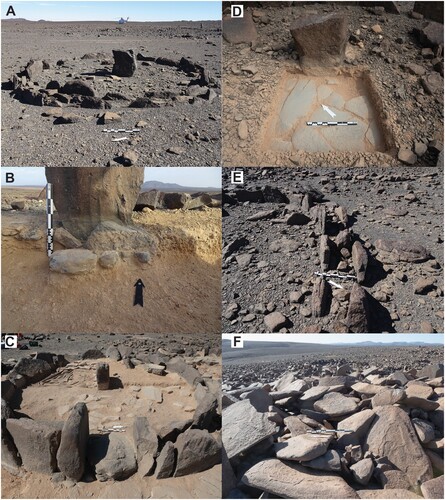
The stones utilized in the construction of these buildings vary in size, but they are typically large unworked slabs, up to 1.8 m long and 0.4 m wide, weighing up to 1 tonne. The height above ground level of the wall slabs ranges from 0.3–0.8 m. The central stone is a single, roughly rectangular slab, placed on its short end and packed with small cobbles. The stones measure between 0.2 and 1 m in height, and occasionally additional smaller slabs are stacked perpendicularly on top, to create a taller column-like structure. These stones are interpreted as structural elements intended to support a superstructure. Although appearing precarious, the arrangement must have been fairly stable and functional when weight was placed on top of the stones to hold them in place.
Several variations for the superstructure of the single Standing Stone Circle structures can be discerned. The majority (n = 28) of surveyed examples have no evidence of further stone masonry or roofing, making it possible that the void between the perimeter rows of slabs functioned as a foundation trench to support organic walls and roofs (cf. Wadi Jilat 26, Garrard et al. Citation1994). A small number of single Standing Stone Circles have partially intact and collapsed roofs, constructed of stone slabs measuring up to 1.7 m in length. These stones were laid on the outer walls, often sitting on 3–5 courses of dry-stone masonry overlying the upright stones, cantilevered with other large slabs (F). Roofed structures are characterized by a high degree of collapse impeding identification from aerial photography and making them prone to misidentification as burial structures (cairns).
Multi-Standing Stone Circles
A second, larger type of Standing Stone Circle has also been identified. Multi-Standing Stone Circles are large sub-circular enclosures measuring between 9 and 24 m in diameter. The perimeter of these structures are built using the same upright stone construction technique used for the single Standing Stone Circle (i.e., a single, or a double concentric, row of upright megalithic stone slabs). However, in contrast to the single Standing Stone Circle, the multi-Standing Stone Circles are characterized by further concentric rows of internal upright stones, positioned between 0.5 and 2 m apart (A). These structures exhibit a high degree of variation in their form and shape, with semi-circular or crescent shaped structures identified (B). Likewise, two examples have ‘S’-shaped internal walls. These structures typically have multiple doorways.
Figure 5 Multi-Standing Stone Circles. A: simple multi-Standing Stone Circle; B: collection of partial multi-Standing Stone Circles.
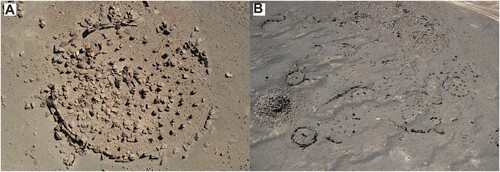
Three multi-Standing Stone Circle structures have been excavated across the Harrat ‘Uwayrid, each at a site where a single Standing Stone Circle was also identified and excavated. The results of these excavations are excluded from the data presented below; they seem to represent a different aspect of the occupation pattern of these sites and will be examined elsewhere.
Site configuration
The Standing Stone Circle sites exhibit a range of forms in variable densities. A small number of sites are wholly composed of single and multi-Standing Stone Circles, with up to 25 in a single cluster (A). Of the excavated examples presented here, IDIHA-F-0000134, IDIHA-F-0011030, IDIHA-F-0011045 and IDIHA-F-0011050 fall into this category. The last three are located at the same site, IDIHA-0001825 (). These sites are often overbuilt with tomb structures in later periods.
Figure 6 A: IDIHA-0001825 comprising multiple discrete simple and complex Standing Stone Circles denoted by white arrows (overbuilt by later tombs); B: IDIHA-0004612 comprising a single Standing Stone Circle — measuring 5.5 m (IDIHA-F-0029843) adjacent to a complex enclosure.
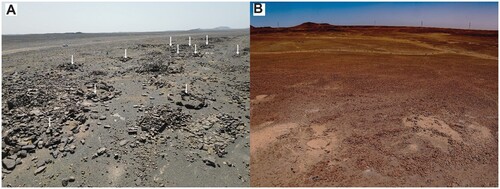
The majority of sites have one single or multi- Standing Stone Circles in close proximity to a complex enclosure(s). Alternatively, some of Standing Stone Circles are built into developed and complex stone enclosures, with low rubble walls abutting the exterior of the more formal standing stone wall (B). Of the excavated examples presented here, IDIHA-F-0007224, IDIHA-F-0007236, IDIHA-F-0029843 (B), and IDIHA-F-0029844 are of this type. The structures appear to have no phases of rebuilding, or expansion. In two excavated examples, complex enclosures were chronologically related, and functionally consistent with the main Standing Stone Circle, based on similarities in their finds assemblages (see below).
Geology and distribution
Three primary geological formations are found in AlUla, which each creating a varied topographical and hydrological environment with implications for the creation, preservation and documentation of archaeological sites. These are: the Precambrian Arabian Shield; the flat-lying, reddish-brown Palaeozoic (Cambrian) sandstones; and the black Cenozoic basalts that overly both the Precambrian Shield and the Palaeozoic sandstones. These basalt deposits form the distinctive ḥarrah landscapes that range in age from around 10 million years ago to less than 1000 years.
To date, 345 Standing Stone Circles have been identified through aerial survey across the Harrat ‘Uwayrid. Standing Stone Circles have also been identified across the Harrat al-Zabin and Harrat Khaybar.
On the basis of our countywide survey, it is suggested that the visibility of these structures is best on ḥarrah landscapes, where the use of large, durable basalt stone, is coupled with slow geomorphological processes since the end of the Holocene Humid Phase. Due to their age, the older, more weathered Miocene lava fields that form the southern areas of the Harrat ‘Uwayrid have flat or gently undulating surfaces of basalt boulders, fractured by diurnal temperature extremes (Edgell Citation2006). Larger boulders form the basic building material for the Standing Stone Circle structures.
Beyond the ‘Uwayrid, water erosion has created a deeply incised landscape of vertically-walled canyons and mesas, whose exposed upper elevations have been sculpted by wind abrasion to form irregular-shaped ridges, or yardangs. Whilst the current study focuses on the occupation of the Harrat ‘Uwayrid, it is worth noting that 24 architecturally consistent Standing Stone Circle sites have been identified in these sandstone environments. This suggests the phenomenon is not geographically constrained to the ḥarrah, but their identification through aerial survey is inhibited by both erosional processes which degrade surface structural remains, or aeolian deposition which conceals them. Anthropogenic processes are also likely to influence their preservation and identification in these areas.
An association between Neolithic occupations and freshwater sources has been demonstrated in Arabia (e.g., Breeze et al. Citation2015; Guagnin et al. Citation2020), a pattern Standing Stone Circles broadly conform to, being typically located on the low rises and ridges of the undulations, overlooking wide shallow valleys or wadis. Although the hydrology on the Harrat ‘Uwayrid has not been extensively studied, landscape features observed during seasonal fieldwork suggest a variety of water sources may have been available. The low valleys that surround the ridges feature the occasional small ‘qa, (mudflats) formed by the accumulation of sediment in small depressions. Also common are smaller depressions locally referred to as rawdah (روضة, gardens or meadows), these can be seasonally verdant, dependent on winter rainfall, and continue to provide pasture for modern herds of caprines and camels. Water and vegetation growth in these moisture-laden basins would have been foci for early settlers on the ḥarrah (Breeze et al. Citation2015). While basaltic stone is generally impermeable, the high degree of weathering on the Harrat ‘Uwayrid allows drainage to the underlying sandstones, where troughs and reservoirs retain standing water into the summer months. The incised valleys of Cambro-Ordovician sandstones to the east of the Harrat ‘Uwayrid are characterized by denser vegetation, primarily Acacia sp., with seasonal wadi flows throughout the winter. Waterflows also feed a series of springs at the base of the cliffs, sustaining agricultural villages in historical periods. Collectively, these sources provide for the availability of water and vegetation across the ḥarrah and its vicinity, and were likely to be more abundant and enduring in the 5th and 6th millennia BCE (Dinies et al. Citation2015; Neugebauer et al. Citation2022).
Dating
The following chronology of the Standing Stone Circle sites has been established through the radiocarbon dating of 44 samples of animal bone (bioapatite) and charcoal collected from stratified deposits (full results in Supplemental Material). Complete sequences from five single Standing Stone Circles have been dated, along with three additional structures subject to test excavations ().
Figure 7 Radiocarbon dates from excavated contexts in eight single Standing Stone Circles. All samples presented here are faunal remains dated using bioapatite.
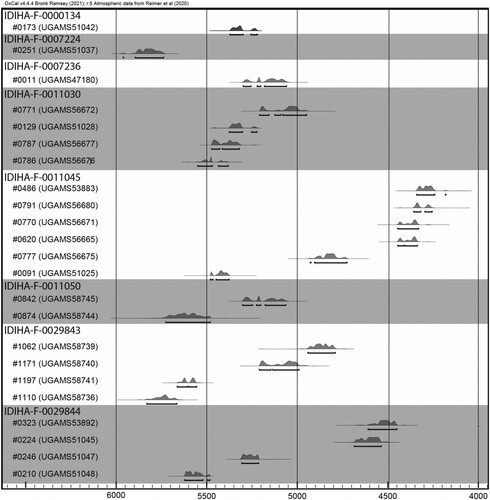
Dates are spread across the 6th and 5th millennia BCE, with some structures revealing discrete concentrations that suggest at least two phases of occupation across these sites (). All eight single Standing Stone Circles excavated to date have at least one phase of activity between 5900–5100 BCE. These are typically associated with the construction and first occupation deposits. A particular clustering of dates in the second half of the 6th millennium BCE suggests this period may represent the peak of Neolithic activity at these sites. Four of these structures also had a number of stratified deposits that were dated to the 5th millennium BCE. Of these, IDIHA-F-0011045 and IDIHA-F-0029844 contained clusters of dates that indicate occupation between 4700–4300 BCE, showing a secondary phase in the life of these structures.
In the majority of excavated structures, however, it is difficult to firmly identify distinct phases of use, due to the lack of clear stratigraphy and formal occupation surfaces. Extensive sampling within individual structures has been undertaken to clarify this. Variable dates from within a single deposit suggest sediment accumulated slowly. There is no stratigraphic evidence, in the form of sterile layers, or architectural modifications, and refurbishments, to support a complete period of abandonment between the two broad phases of use.
Finds
Complete assemblages from five fully excavated single Standing Stone Circles are described below (IDIHA-F-0011030, IDIHA-F-0011045, IDIHA-F-0011050, IDIHA-F-0029843, and IDIHA-F-0029844).
Lithics and groundstone
The Standing Stone Circle sites have rich assemblages of knapped and groundstone artefacts. Excavations at five single Standing Stone Circles () yielded a total of 220.8 kg of knapped stone artefacts. Local basalt is the dominant material used in these large knapped assemblages, comprising a majority of lithics by count, and 98% by weight in the sample (). This technology is typically informal and expedient, characterized by simple core reduction strategies. Attribute analysis of lithics from IDIHA-F-0029844, indicates 8% of the basalt flakes >20 mm are retouched, with forms including notches, denticulates, scrapers and heavy-duty ‘choppers’ (unstandardized ‘core-tools’) exhibiting macroscopic edge-damage apparently from use (). There is rare evidence for formal basalt tools, including a single groundstone axe () and two axe rejuvenation flakes, but, surprisingly for extensive Neolithic basalt working, the vast majority of basalt artefacts are unrelated to axe production.
Table 1 Summary of lithic assemblages by material weights (g) recovered through excavation at the discussed single Standing Stone Circle features
Table 2 Summary of retouched and groundstone artefacts (frequencies and percentages) recovered through excavation at the discussed single Standing Stone Circle features
Basalt and sandstone slabs were regularly used for grindstones and mullers, with a maximum frequency of 83 groundstone artefacts recovered from a single Standing Stone Circle (IDIHA-F-0029843), including 11 complete grindstones reused within the floor architecture (). Basalt grindstones and mullers also exhibit expedience, typically showing no or minimal preparation or maintenance, presumably becoming disused once the original surface was too smooth for efficient pulverization. Sandstone examples more regularly exhibit rejuvenation through pecking, possibly showing greater curation of a resource that is not immediately accessible on the Harrat ‘Uwayrid. The iron-rich shale (haematite) formations described by Lucarini et al. (Citation2023) are also present within the Cambro-Ordovician sandstone at the base of the Harrat ‘Uwayrid, and show regular utilization at Standing Stone Circle sites; this includes a refitting knapped core, rubbed crayon pieces and grinding-stone surfaces covered in red pigment ().
Materials with finer crystalline structures were habitually transported to the Harrat ‘Uwayrid for the production of miniature tools; particularly quartz, chert, chalcedony and, occasionally, obsidian, collectively comprising 2% of the studied lithic assemblages by weight. Two sources of quartz are recognized from the assemblages; secondary pebbles that erode from sandstone exposures at the base of the ‘Uwayrid, as well as unrolled ‘rock crystal’ taken from seams within the Precambrian Arabian Shield. The variation in chert colouration and fabric texture indicates multiple sources, while frequent cortex suggests these are local to the AlUla region. Introduced knapping materials were reduced through a combination of freehand and bipolar percussion, with the bipolar technique preferred for small cores — many of which show full exhaustion, occasionally weighing >1 g and measuring >1 cm at the point of discard. Approximately 2% of quartz flakes and 8% of chert flakes are retouched; formal tools were almost exclusively produced from chert, including drills, tabular scrapers and pressure-flaked arrowheads.
The formal tools show clear affinities to Late Neolithic Levantine technology ( and ). The arrowheads adhere to Ha-Parsa (50%), Nizzanim (24%), Herzliya (12%) and transverse (2%) types, besides some irregular (12%) forms (Shea Citation2013) (n = 42) (A–B). These types are commonly identified in Pottery Neolithic (PN) assemblages in the Levant; particularly Ha-Parsa, Nizzanim and Herzliya types, which are considered a technological group (Gopher Citation1994: 219). The proportional representation of these three arrowhead types at Standing Stone Circle sites is comparable to surface collection at the Levantine type site of Givat Ha-Parsa (n = 1050), where Ha-Parsa types comprized 51%, Nizzanim 32% and Herzliya 6% (Gopher Citation1994: 149). Similar ratios are also reported in Yarmoukian levels at ‘Ain Ghazal in western Jordan, discounting large Byblos, Amuq and Jericho projectile points, believed to be scavenged from earlier occupation phases (Barket Citation2016). Complete arrowheads from the Harrat ‘Uwayrid sites are consistently smaller than examples from the Levant. PN arrowheads from ‘Ain Ghazal (n = 46) have an average length of 30.6 mm (Barket Citation2016: 141), whereas the ‘Uwayrid arrowheads only average 18.1 mm. Arrowhead miniaturization in the Levantine Late Neolithic has been suggested to represent either a shift to prolonged tool curation (Barket Citation2016) or functional changes (i.e. smaller prey or poison use) (Shea Citation2013).
Figure 9 Typical retouched chert artefacts. A–F Arrowheads: A–B, D–E Ha-Parsa points; C, F Herzliya points. G Plano-convex tool. Scale is 2 cm long.
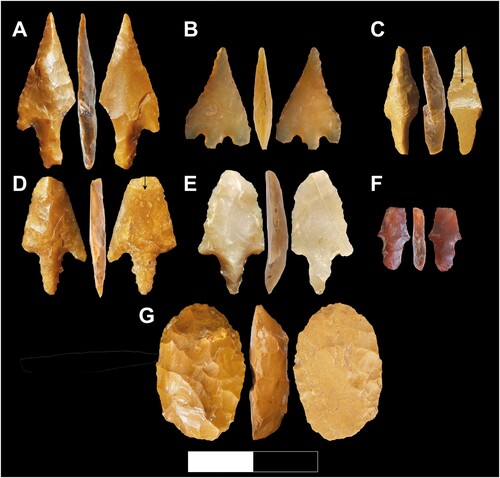
Artefacts recovered from the Standing Stone Circle sites include recurrent forms not recognized in other Arabian or Levantine industries; most distinctly, the use of small, pressure-flaked plano-convex tools. These are retouched around their whole circumference (dorsally or bifacially) and show attention to symmetry, typically as oval forms (F–G). They range from 16.2 to 36.6 mm in length (mean = 23.1 mm), from 2.8 to 11.9 mm (mean = 5.9 mm) in thickness, and in edge angle from 45 to 72° (mean = 55°). It is unclear from the current sample whether these artefacts represent specialized or generalized tools for cutting or scraping activities; one possibility is that they are formal knives, perhaps subject to prolonged curation and resharpening. Whilst bearing similarities in form to some bifacial knives found in Arabia (Crassard and Hilbert Citation2019; Fig. 7), differentiation in their asymmetric profile and shape suggest a local industry.
Another unusual artefact type recovered from these sites are small cone-shaped objects ground from sandstone (n = 2) (A) and a hard sedimentary rock (n = 1) (B). There are no clear counterparts to these artefacts from other Neolithic assemblages within Arabia. Comparable objects found in East African Neolithic contexts have been identified as rubbers or drills, with different uses assigned to the working on both the flat and conical surfaces (Jordeczka Citation2011: 309). The chipping on the base of ‘Uwayrid examples suggests use as pestles, whilst the irregular flat surfaces of the conical shapes suggest working of these surfaces.
Faunal remains
An assemblage of fragmentary faunal remains (summarized in ) has been analyzed from five separate structures (6240 bones; 6442 g), with 25% of total remains identifiable (1550 NISP, number of identified specimens; 2915.4 g).
Table 3 Summary of faunal remains recovered through excavation at the discussed single Standing Stone Circle features listed by NISP and %NISP and weight
The assemblages from all structures contain comparable faunal spectra, dominated by small ruminants (87% of the NISP), namely caprines of different ages (43.8% of the NISP), among which domestic goat and sheep are identified (6.7% of the NISP). A lower but recurrent occurrence of bones are identified as wild fauna (namely equids, gazelles, but also hares, rodents, birds, altogether 1.6% of the NISP). Bovine remains are present in multiple structures (1.5% of the NISP), but cannot be identified to species. However, domestic cattle is attested in Neolithic northern Arabia, with confirmed domesticated species identified in multiple ritual contexts (Abu-Azizeh et al. Citation2023; Kennedy et al. Citation2023) and extremely limited evidence in domestic contexts (Guagnin et al. Citation2017). Evidence for the exploitation of domestic cattle in the PPNB settlements of the western Jordanian highlands, in conjunction with the piecemeal evidence currently available for the southern Badia (Makarewicz Citation2020) supports the interpretation of these as domesticates, possibly introduced directly from the Levant. The same may apply to domestic goat and sheep, also documented in ritual contexts (Abu-Azizeh et al. Citation2023; Kennedy et al. Citation2023).
When examined in conjunction with dating evidence, the present assemblage offers some insight into when domesticates arrived on the Harrat ‘Uwayrid. Sheep and goat remains have been identified in the earliest occupation deposits, dated to the first half of the 6th millennium BCE. The earliest bovine remains date to the second half of the 6th millennium BCE (5549–5383 cal. BC, #0786-UGAMS56676; 5471–5310 cal. BC, #0774-UGAMS56673).
Although fragmentary, the assemblage does confirm the exploitation of domesticates as a food source. All body parts are present (head, limbs, axial skeleton) suggesting local availability of the animals. Butchery marks, observed on 21 bone fragments, indicate anthropic exploitation, although such marks are likely under-represented due to surface accretion prohibiting observation. Fire traces are also present on 3.4% of the total NISP. In conjunction with the presence of shattered bone in hearth deposits this is a further indication that these remains can be considered dietary refuse.
Small finds (excluding flaked stone)
In addition to the substantial assemblages of functional stone artefacts and faunal remains, a limited collection of small finds has been recovered from Standing Stone Circle sites. These comprise shells, worked bone and small carved or groundstone items.
A range of worked and unworked or fragmentary shells were recovered, with both gastropods and bivalves being present. Identification was generally only possible to genus level. All genera are found in the Red Sea, approximately 120 km to the west, although no endemic species were identified. Eighteen individual shell beads have been identified, the majority of which (n = 12) are complete Conus sp. shells. The bead is formed by a single perforation through the apex. The presence of a small number of unworked conus shells (n = 3) suggest shells may have been brought to the Harrat ‘Uwayrid complete and worked locally. Examples of shell beads are temporally and geographically dispersed. Regionally, similar beads date two to three millennia later (Hausleiter et al. Citation2018). Neolithic examples are known in Levantine and Sinaitic contexts (Betts Citation1998: 138), as well as southern Arabian examples from as early as the 7th millennium BCE (Crassard et al. Citation2020). As such, these shells are a poor chrono-cultural marker for the region, but indicate importation of material from the coast during the Neolithic.
Ornamental objects also include a range of carved and groundstone items. Six stone ‘rings’ carved from sandstone and limestone have been recovered to date, all of which were broken. Functionally they are commonly identified as bracelets, but they are variable in size (Starck Citation1988). Their distribution is widespread across western Asia, with evidence for manufacture beginning in the Neolithic and continuing into the Bronze Age. Their presence in the arid zone is currently limited to Late Neolithic contexts, such as Wadi Jilat and Burqu in the eastern Jordanian Badia (Baird et al. Citation1992; Betts et al. Citation2013), as well as at Oraf 2 in the Nefud Desert (Guagnin et al. Citation2021). Other carved stone objects may be described as pendants, or hanging ornaments: these are made in a range of stone materials not naturally occurring on the Harrat ‘Uwayrid. Each is ground and polished to an ovoid shape, and has a pierced hole in one end ().
Figure 13 Small finds found in single Standing Stone Circles: A. Carved stone ring; B–C. Carved stone pendants; D. Conus shell bead; E. Bone point; F. Bevelled bone tool. Scale is 5cm long.

In addition to the faunal remains with evidence of butchery, a small group of worked bone tools have also been collected (n = 18). Ten were made from small ruminant bones, five from large ungulates, and represent selectivity of bones based on the size of the intended tool. Two main forms have been identified, pointed tools and flat bevelled tools, similar to examples found at Early through to Late Neolithic sites in the Levant (Betts Citation1998; Rollefson et al. Citation2016). They are commonly identified as awls and scrapers, associated with the processing of animal skins (Taha Citation2015).
Discussion
There is, currently, limited published evidence regarding how people lived in north-west Arabia prior to the 3rd millennia BCE. The scarcity of assemblages has curtailed detailed discussions regarding basic aspects of material culture, architecture, settlement patterns and subsistence practices. In particular, lack of occupational evidence has resulted in assumptions regarding the degree of mobility within these communities. Work undertaken on the Standing Stone Circle sites has provided substantial new evidence of late prehistoric human activity on the Harrat ‘Uwayrid. On this basis, a preliminary chrono-cultural description of the Neolithic in AlUla can be proposed.
Domestic architecture
The distinguishing feature of the Standing Stone Circle sites is the ubiquitous use of upright stones in the Standing Stone Circles themselves, along with the dense clustering of the structures. The Standing Stone Circle structures are not unique in their overall form and concentrations of similar, clustered, subterranean oval structures have been found across the arid zones of the Levant, and typify the hunter-herder camps of the late Neolithic (Abu-Azizeh Citation2013; Betts Citation1998; Rollefson et al. Citation2014; Rosen Citation2016). However, the identification of these sites as places of intensive occupation was not immediately evident due to the limited evidence for domestic architecture in prehistoric Saudi Arabia. The use of standing stones is known at several sites throughout Saudi Arabia (Almushawh Citation2018), most of which have been ascribed a cultic function. The use of upright stones in combination with coursed masonry walls has also been noted at the ‘open sanctuaries’ in the Wadi Mohorak and Wadi Ghubai. These structures combine a large, simple enclosure, with well-built walls and a roofed rectangular structure abutting the eastern wall (Fujii Citation2016). However, in the absence of any functional evidence their identification as sanctuaries is, at this stage, hypothetical.
Elsewhere in the far north of Saudi Arabia, the use of upright stones has been noted in relation to hydraulic and funerary structures in the Wadi Sirhan (Gebel Citation2016). Many of these are identified as ‘D-shaped ashlar lined graves’, and well/trough structures dated to the 5th and 4th millennia BC. A single structure excavated at Rasif was identified as a dwelling and dated to the Neolithic on the basis of pottery and lithic finds (Gebel Citation2016). However, further architectural or functional comparisons between these features and the Standing Stone Circles will require more extensive publication of the excavated deposits and dating at Rasif.
The architectural uniformity of the two concentric walls of upright stones which typify the Standing Stone Circle is distinct but not unique. Beyond Saudi Arabia, a small number of relevant comparisons can be found in the Jordanian Badia. A notable collection of late Pre-Pottery Neolithic B (PPNB) and Late Neolithic camp sites located at Wadi Jilat in the Azraq basin have been documented, with single rows of upright stones forming a series of simple and complex enclosure groups (WJ26 and WJ25) (Garrard et al. Citation1994). These structures also replicate the patterning of the Standing Stone Circles internal architecture and spatial use. Stone lined hearths and ashy floor deposits, benches and paved work surfaces, as well as open, informal annexes for processing activities have been identified (Garrard et al. Citation1994). Even though these sites are located some 500 km kilometres away, they provide a useful precedent for the use of this construction method in domestic contexts.
At Wisad Pools in the eastern Harrat al-Sham (حَرَّة ٱلشَّام), north-eastern Jordan, a series of circular stone enclosures have been excavated featuring one or more internal standing stones. In contrast to the upright stones found in AlUla, these stones have been ascribed a socio-ritual function, rather than a functional one. This determination was made on the basis of the low height of the stones, and associated deposits of gazelle bones and possible cultic installations (Rollefson Citation2022).
In the Jafr basin, south-eastern Jordan, the double-rowed, upright-slab wall technique has been recorded in ‘pseudo-house’ funerary monuments. These rectangular structures are arranged linearly and incorporate a single cairn, devoid of cultural material. They are interpreted as a funerary adaptation by Late Neolithic pastoralists of earlier PPNB settlements (Fujii Citation2013; Citation2020).
The continuity of the architectural styles throughout the Badia may speak to a practical exploitation to the tabular nature of available bedrock sources. Its limited use may also suggest a shared architectural tradition, one that extended into northern Saudi Arabia. This construction technique is employed in a range of forms with varying functions across these disparate arid landscapes, with variable ritualized or socially constructed meanings. Further investigation and consideration is required in order to better understand how these different practices relate to each other.
The abundance of expediently worked basalt seems to be a particular feature of the Harrat ‘Uwayrid Standing Stone Circles sites; interestingly such assemblages are not known from Neolithic hearth sites interpreted as more temporary camps (Guagnin et al. Citation2021; Scerri et al. Citation2018). Informal tools on coarse-grained material have appeared in lithic assemblages since the Palaeolithic, with ethnographic evidence indicating their utility in working very hard woods such as Acacia (Hayden Citation2008). We hypothesize that the informal basalt tools may have been used in the creation and maintenance of wooden superstructures for the Standing Stone Circles.
Date range of the Neolithic in AlUla County
The large suite of radiocarbon assays collected from the Standing Stone Circle sites can be used to situate AlUla within a wider regional and chronological context. These dates and sites also provide a starting point for the establishment of a regionally specific chronology for the Neolithic in north-west Arabia. The earliest evidence of Neolithic occupation in AlUla correlates to the beginning of the 6th millennium BCE, but, the Standing Stone Circle tradition only appears to be well established by the middle of that millennium. On the basis of the homogenous cultural sequences identified across the Standing Stone Circle sites, it appears that occupation of these sites continued into the mid-to-late 5th millennium BCE. Taking Ha-Parsa points as a chrono-cultural marker within a single structure (IDIHA-F-0011045), consistent arrowheads were recovered from all occupational phases of the structure (C–F) across approximately 1200 years of use. The shallow depth of deposits — generally between 0.1 and 0.5 m in total — suggest occupation was unlikely to be continuous throughout this period. Although, taphonomic processes affecting the formation of assemblages in these environments is largely unknown, aeolian deflation of sediments was also likely to be occurring in between periods of occupation. In general, uniformity of the assemblages, in addition to the lack of evidence of architectural modification of spaces, indicates cultural homogeneity across the life of the structures.
Occupation of the Standing Stone Circles appears to cease in the middle of the 5th millennium BCE. Yet, these sites continue to be reused, for the construction of funerary monuments, for at least a further 1000 years. This is most clearly demonstrated by the collective grave excavated at site IDIHA-0001825. The grave contained 11 individuals buried across a 600-year period (Thomas et al. Citation2021b). The oldest of these burials coincides with the final phase of occupation in at least one dwelling, a rare example of intramural burial in the region. The continued use of this grave suggests ongoing visitation to the site, whilst numerous simple cairns and tower tombs demonstrate use into the 1st millennium BCE (Kennedy et al. Citation2021). Longer term use of the sites following the cessation of occupation is further evidenced by the association with the later funerary avenues (Dalton et al. Citation2021). These tomb-lined paths speak to an ongoing cultural use of the landscape, notwithstanding the practical factors likely to influence such patterns of mobility.
The dating of the Standing Stone Circles also correlates with evidence of Neolithic activity across north-west Saudi Arabia. This includes the Camel Site in al-Jawf (5641–5555 BCE, Charloux et al. Citation2022), Jebel Oraf in the southern Nefud (5300 BCE, Guagnin et al. Citation2021), and Alshabah in the western Nefud (5300 BCE, Scerri et al. Citation2018). This may suggest a florescence of activity across the region at this time, and could be linked to the expansion and establishment of pastoralism across north-west Saudi Arabia.
Regarding the chrono-cultural phasing, the Standing Stone Circle sites, c. 5900 BCE, may be placed within the Late Neolithic cultural phase of the southern Levant at sites including Burqu (Betts et al. Citation2013), and structures SS-11 at Wadi-al Qattafi and W-80 at Wisad Pools (Rowan et al. Citation2020). Although the importation of cultural chronologies from other geographic regions is not unproblematic, typological similarities across the flaked stone assemblages of both regions supports the use of such terminologies as a convenient point of reference for broader regional comparisons.
Nomadic or merely pastoral?
In the absence of other cultural markers relating to the Neolithization processes in arid locales like AlUla, emphasis is generally placed on the development, or introduction, of mobile pastoralism. While the true nature of mobility and sedentism in this region remains unknown, some preliminary inferences from the Harrat ‘Uwayrid assemblages can be made. Firstly, the practice of pastoralism is clearly evidenced through the faunal assemblages. The assemblage indicates a significant reliance on herding (namely small stock), supplemented by the hunting of local taxa. The introduction of domesticates, specifically sheep and goat, in both northern Arabia and the Levantine periphery, provided these communities with the flexibility and resilience to respond to environment and resource variability including weather, water, vegetation and fuel, amongst others (Drechsler Citation2007; Garrard et al. Citation1996; Martin Citation1999). The presence of tabular scrapers may be significant in this regard; it has been suggested that they primarily functioned as shearing tools, butchery tools and hide-working tools from the Pottery Neolithic to the Early Bronze Age in the Levant (Barket and Bell Citation2011; Yerkes et al. Citation2016; Zutovski et al. Citation2016).
Like elsewhere in the arid zone, the nature and extent of population mobility was likely a factor in the success of this model. Extant faunal data is inconclusive, but other materials suggest that the occupants of the Harrat may have practiced a degree of transhumance, accessing resources not available on the harrat. Chert, quartz, pigment and sandstone materials from the valleys below the Harrat ‘Uwayrid are commonly found in the Standing Stone Circles. The appearance of Red Sea shells and exotic stone materials suggests developing networks of trade and exchange, concurrent with mobility, while seasonal use of the structures might explain the need for stone artefacts to continually rejuvenate the superstructure.
Beyond this, a lack of regionally specific environmental reconstructions limits the extent to which we can predict the seasonal availability of vegetation and water for foddering herds, and hence its role in establishing mobility patterns. In the modern era, transhumance between the ḥarrah and valleys is the basis of the region’s pastoralism. Mobility is driven by local knowledge regarding availability of pasture and water, based on a combination of seasonal rainfall and water-retaining landforms, in addition to perennial springs. Herds are taken up onto the Harrat ‘Uwayrid for both the lower temperatures and higher-quality vegetation produced by the volcanic soils of this region. The duration of their grazing here is dictated by the extent of winter rains and the availability of surface water into the summer months. Whilst drawing an analogy with modern pastoral models is imperfect (Makarewicz Citation2013; Rosen Citation2016), such practices provide a localized proxy for resource exploitation. Notwithstanding resource-acquisition-driven mobility, the regional evidence for the amelioration of climactic conditions during the 6th millennium BCE (Petraglia et al. Citation2020) indicates that the Harrat ‘Uwayrid may have allowed for a higher degree of sedentism.
The unprecedented size and complexity of Standing Stone Circle sites provides evidence for a greater degree of sedentism in the AlUla region during the Neolithic than has hitherto been documented in northern Arabia. In the eastern Jordanian Badia, Betts (Citation2008: 36) proposes that sites with ‘robust structures, greater depth of stratigraphy and a wider range of artifacts suggest that the steppe was certainly used for a substantial portion of the year when water supplies [elsewhere in the Badia] were limited’. These sites are typified by the above mentioned occupations at Wadi Jilat and Wisad Pools. Conversely, high-frequency, low-density sites are indicative of short-term occupation in areas with widespread, seasonally variable, water sources. In AlUla, the distinction between simple and complex enclosures as short- or long-term occupation sites (respectively) is perhaps too straightforward. Indeed, in the case of Standing Stone Circles, their identification at a range of site types, from a single isolated structure, to the great concentrations covering up to 3 ha, will require further study to untangle possible chronological, functional and cultural factors. Regardless, the size and number of structures at Standing Stone Circle sites raises questions regarding how ‘temporary’ the occupation of these sites really was.
To this, the diversity of assemblages excavated in Standing Stone Circles is also a significant factor. It can be suggested that the combination of substantial architectural constructions, relatively deep stratigraphic sequences, and diverse assemblages of functional items and small finds, points to a degree of sedentism at Standing Stone Circle sites across the Harrat ‘Uwayrid.
Cultural signature of the Neolithic in north-west Arabia
On the basis of material culture and chronometric evidence it can be suggested that a homogenous cultural sphere existed within Standing Stone Circle sites across the Harrat ‘Uwayrid. The assemblages of flaked stone are dominated by large and informal basalt flake production, alongside a diverse selection of introduced knapping materials used for smaller tools. Formal tools are of a limited, but homogenous, toolkit, primarily projectile points. The arrowheads attest to Neolithic hunting on the Harrat ‘Uwayrid, with two specimens exhibiting damage to the tips consistent with impact (). Despite the exploitation of wild taxa locally, as evidenced in the faunal remains and also by hunting traps (Repper et al. Citation2022), the faunal assemblages are predominately domesticates, contrary to comparable assemblages in eastern Jordan (Martin Citation1999).
The large numbers of grindstone and muller fragments found throughout the structures provides further insight into the subsistence of these communities. The breakdown between the use of grindstones for plant and meat processing is currently unknown. However, a use-wear analysis of grindstones recovered from Neolithic contexts at Jebel Oraf revealed plant, bone and pigment processing using these tools (Lucarini et al. Citation2023). It is likely that similar activities are represented at the Standing Stone Circle sites, with the processing of cereals (whether wild or domesticate is unknown) and tubers, as well as other plant and animal materials.
Beyond the ‘Uwayrid, similar aspects of material culture and mixed subsistence have been evidenced at a small number of hearth sites across the Nefud Desert, with Ha-Parsa and Herzliya arrowhead types, ground-stone technologies, as well as caprine and bovine domesticates. However, no structural remains were present at these sites (Guagnin et al. Citation2020; Scerri et al. Citation2018). It has been suggested that these sites were part of a high-mobility lifestyle, relying on variable water and pasture between the oases and interdunal depressions; an adaptation to regional arid environments (Guagnin et al. Citation2021). This may now be reinterpreted as localized adaptation to the sand seas, within a larger settlement pattern informed by the variable hydrological and ecological resources across the diverse environments of north-west Saudi Arabia.
The diversity of small finds recovered across multiple sites, including items of ornamentation, further elucidates the culture of this period. The assemblage of small finds is more diverse than those typically recorded during the excavation or survey of sites in similarly arid regions (Betts et al. Citation2013; Rosen Citation2002). In the Badia, such varied assemblages were attributed to a diversity of community, as opposed to the smaller range of artefacts found in ephemeral and seasonal camps occupied by a sector of the population. This is predicated on the assumption that a community settled in one place has the ability to accumulate, or will require a greater range of ornamental and/or non-functional items (Betts Citation2008; Fujii Citation2020).
The connected but discrete nature of the Neolithic in AlUla is becoming apparent. Varying degrees of weight have been given to the influence of Levantine groups in the Neolithization processes of the Arabian Peninsula (Crassard and Drechsler Citation2013; Gebel Citation2019), but a strong cultural influence has been evidenced across the north-west. Standing Stone Circle sites demonstrate affinities with the assemblages from Burqu and al-Girqa in the Harrat al-Sham (Betts et al. Citation2013) both in the form of distinctive tool types, as well as the presence of morphologically distinct domesticated sheep, which have no local antecedents (Martin Citation1999; Martin and Edwards Citation2013). Like many of these other assemblages, the lithic technology from Standing Stone Circle sites demonstrates aspects of continuity with other industries in the southern Levant. In particular, arrowheads provide the clearest relationship to other Neolithic communities with direct parallels to the southern Levantine tool kit, particularly the Ha-Parsa, Nizzanim and Herzliya technological groups.
Despite the clear Levantine technological influences, significant autochthonous cultural elements are present. The geographic and chronological overlap between the Standing Stone Circle sites and Mustatil phenomenon is of particular significance. Both traditions span the final centuries of the 6th millennium BCE, into the early 5th, overlapping geographically across AlUla and Khaybar. Whilst direct association is rare, it appears likely that these two megalithic structure types are aspects of a single cultural entity. Each of these structures typically contain consistent assemblages of lithic material, predominately domesticated fauna — albeit in varying quantities and frequencies of taxa (Kennedy et al. Citation2023). The small assemblages of material culture found in Mustatils excavated to date inhibits further direct comparison of this, but the investigation of domestic sites found in association with Mustatils will provide an interesting avenue for future research. If Mustatils form part of a pilgrimage for communal gathering and feasting (Kennedy et al. Citation2023), this may represent a dimension of the mobility pattern of the communities who lived at the Standing Stone Circles. It may be hypothesized that north-west Arabia hosted a distinctive, socially integrated, but regionally connected, culture, of which the Standing Stone Circles were one expression of a wider settlement pattern. Like elsewhere, these groups responded to the local ecological and environmental conditions in variable but consistent ways utilizing knowledge of these landscapes to exploit changing resources.
Conclusion
The Standing Stone Circles of the Harrat ‘Uwayrid provide the first extensive evidence for architectural and domestic occupation in the Neolithic of north-west Saudi Arabia, as well as the first clear chronometric parameters for the period. Collectively, evidence from the Standing Stone Circles contrasts distinctly with the notion that ‘technological, subsistence and social dynamics in northern Arabia were largely local’ (Crassard and Drechsler Citation2013). The similarities in elements of the material culture across formal tool types, decorative elements and architecture, demonstrate clear influences and knowledge of technologies from their northern neighbours, supporting the suggestion of either multiple population incursions or interactions across the Middle Holocene (Gebel Citation2019: 123). Despite this confluence of influence, the local character of the Neolithic must also be highlighted, with significant authochthous factors in the region’s Neolithization process. As such, we must seek to understand the variable manifestations of the local and introduced processes across the north-west to contextualize Neolithization across the Peninsula.
Supplementary data.docx
Download MS Word (22.3 KB)Acknowledgements
The authors would like to thank RCU for its support in undertaking this work, and extend special thanks to the Governor, His Highness Prince Badr bin Abdullah bin Mohammad bin Farhan Al Saud; Dr Abdulrahman Al-Suhaibani, Dr Rebecca Foote, Dr Wissam Al-Khalil, and Dr Laura Moribito. We must also acknowledge the work and valuable contributions to this study by Professor David Kennedy and AAKSA project team members, Dr Rebecca Repper, Dr Mat Dalton and Dr Don Boyer. Finally, we must thank the many members of the AAKSA field teams, who assisted in the gathering of this data. In particular, Ahmed Abdul-Hamid and our workmen for their tireless work.
Disclosure statement
No potential conflict of interest was reported by the author(s).
Supplemental material
Supplemental material for this article can be accessed here: https://doi.org/10.1080/00758914.2024.2350826.
Additional information
Funding
References
- Abu-Azizeh, W. 2013. The south-eastern Jordan's Chalcolithic–Early Bronze Age pastoral nomadic complex: patterns of mobility and interaction. Paleorient 39: 149–76.
- Abu-Azizeh, W. 2014. Stone enclosures and Late Prehistoric pastoral nomadic campsites: a methodological review of Al-Thulaythuwat case Ssudy, southern Jordan. In, Makarewicz, B. F. C. (ed.), Settlement, Survey, and Stone. Essays on Near Eastern Prehistory in Honour of Gary Rollefson: 187–208. Berlin: ex oriente.
- Abu-Azizeh, W., Studer, J., Alahmari, S., Boyle, B., Dausse, L., Quatermaine, J., Strolin, L., Tombret, O. and Zazzo, A. 2023. The Horn Chamber Mustatil: a Neolithic open-air sanctuary evidencing pastoral nomadic ritual activity in the north-western Arabian Desert (al-'ula[AlUla]). Proceedings of the Seminar for Arabian Studies 51: 133–56.
- Adams, R. M., Parr, P. J., Ibrahin, M. and Al-Mughannum, A. 1977. Saudi Arabian archaeological reconnaissance 1976: preliminary report on the first phase of the comprehensive archaeological survey program. ATLAL: The Journal of Saudi Arabian Archaeology 1: 21–40.
- Almushawh, M. A. 2018. An archaeoastronomical approach to the megalithic sites of Saudi Arabia. Mediterranean Archaeology and Archaeometry 18: 1–9.
- Baird, D., Garrard, A., Martin, L. and Wright, K. 1992. Prehistoric environment and settlement in the Azraq Basin: an interim report on the 1989 excavation season. Levant 24: 1–31.
- Barket, T. M. 2016. The Tool Kit of Daily Life: Flaked-Stone Production at the Household Level at the Neolithic Site of ‘Ain Ghazal, Jordan. MPhil. University of California Riverside.
- Barket, T. M. and Bell, C. A. 2011. Tabular scrapers: function revisited. Near Eastern Archaeology 74: 56–59.
- Betts, A. V. G. 1998. The Harra and the Hamad: Excavations and Explorations in Eastern Jordan. Sheffield: Sheffield Academic Press.
- Betts, A. 2008. Things to do with sheep and goats: Neolithic hunter-forager-herders in North Arabia. In, Barnard, H. and Wendrich, W. (eds), The Archaeology of Mobility: Old World and New World Nomadism: 25–42. Los Angeles: Cotsen Institute of Archaeology.
- Betts, A., Martin, L., Matsaert, F. and McCartney, C. 2013. Prehistoric sites at Burqu’. In, Betts, A. V. G., Cropper, D., Martin, L. and McCartney, C. (eds), The Later Prehistory of the Badia: Excavations and Surveys in Eastern Jordan: 52–133. Oxford: Oxbow Books.
- Breeze, P. S., Drake, N. A., Groucutt, H. S., Parton, A., Jennings, R. P., White, T. S., Clark-Balzan, L., Shipton, C., Scerri, E. M. L., Stimpson, C. M., Crassard, R., Hilbert, Y., Alsharekh, A., Al-Omari, A. and Petraglia, M. D. 2015. Remote sensing and GIS techniques for reconstructing Arabian palaeohydrology and identifying archaeological sites. Quaternary International 382: 98–119.
- Charloux, G., Guagnin, M., Petraglia, M. and AlSharekh, A. 2022. A rock art tradition of life-sized, naturalistic engravings of camels in Northern Arabia: new insights on the mobility of Neolithic populations in the Nafud Desert. Antiquity 96: 1301–09.
- Crassard, R. and Drechsler, P. 2013. Towards new paradigms: multiple pathways for the Arabian Neolithic. Arabian Archaeology and Epigraphy 24: 3–8.
- Crassard, R. and Hilbert, Y. H. 2019. Bidirectional blade technology on naviform cores from northern Arabia: new evidence of Arabian-Levantine interactions in the Neolithic. Arabian Archaeology and Epigraphy 31: 93–104.
- Crassard, R. and Khalidi, L. 2017. Dispersals, connectivity and indigeneity in Arabian prehistory. In, Boivin, N., Crassard, R. and Petraglia, M. (eds), Human Dispersal and Species Movement: From Prehistory to the Present. 219–236. Cambridge: Cambridge University Press.
- Crassard, R., McCorriston, J., Martin, L. and Dye, T. S. 2020. Manayzah: a terminal Pleistocene–Early Holocene rockshelter occupation. In, McCorrison, J. and Harrower, M. J. (eds), Landscape History of Hadramawt: The Roots of Agriculture in Southern Arabia (RASA) Projects 1998–2008: 157–211.Los Angeles: The Cotsen Institute of Archaeology Press.
- Dalton, M., McMahon, J., Kennedy, M. A., Repper, R., Shilali, S. E. A., AlBalawi, Y., Boyer, D. D. and Thomas, H. 2021. The Middle Holocene ‘funerary avenues’ of north-west Arabia. The Holocene 32: 183–99.
- Dinies, M., Plessen, B., Neef, R. and Kürschner, H. 2015. When the desert was green: grassland expansion during the Early Holocene in northwestern Arabia. Quaternary International 382: 293–302.
- Drechsler, P. 2007. The Neolithic dispersal into Arabia. Proceedings of the Seminar for Arabian Studies 37: 93–109.
- Drechsler, P. 2009. The Dispersal of the Neolithic over the Arabian Peninsula Oxford: Archaeopress.
- Edgell, H. S. 2006. Arabian Deserts: Nature, Origins, and Evolution. The Netherlands: Springer.
- Fujii, S. 2013. Chronology of the Jafr prehistory and protohistory: a key to the process of pastoral nomadization in the southern Levant. Syria 90: 49–125.
- Fujii, S. 2016. Wadi Ghubai and Wadi Mohorak sites: protohistoric burial fields in the Tabuk province, northwestern Arabia. In, Luciani, M. (ed.), The Archaeology of North Arabia: Oases and Landscapes. Proceedings of the International Congress held at the University of Vienna, 5–8 December, 2013: 115–134. Vienna: Austrian Academy of Sciences Press.
- Fujii, S. 2020. Late Neolithic cultural landscape in the Al-Jafr basin, southern Jordan: a brief review in context. Studies in Ancient Art and Civilization 24: 13–32.
- Garrard, A., Baird, D., Colledge, S., Martin, L. and Wright, K. 1994. Prehistoric environment and settlement in the Azraq Basin: an interim report on the 1987 and 1988 excavation seasons. Levant 26: 73–109.
- Garrard, A., Colledge, S. and Martin, L. 1996. The emergence of crop cultivation and caprine herding in the ‘Marginal Zone’ of the southern Levant. In, Harris, D. R. (ed.), The Origins and Spread of Agriculture and Pastoralism in Eurasia: 204–26. London: UCL Press.
- Gebel, H. G. K. 2016. The socio-hydraulic foundations of oasis life in NW Arabia: the 5th millennium BCE shepherd environs of Rajajil, Rasif and Qulban Beni Murra. In, Luciani, M. (ed.), The Archaeology of North Arabia. Oases and Landscapes: Proceedings of the International Congress held at the University of Vienna, 5–8 December, 2013: 79–113. Vienna: Austrian Academy of Sciences Press.
- Gebel, H. G. K. 2019. Polylinear incursions and autochthonous adaptations: Neolithisation and sustainable sedentarisation of the Arabian Peninsula. Arabian Archaeology and Epigraphy 31: 119–27.
- Gilmore, M., Al-Ibrahum, M. and Murad, A. S. 1982. Preliminary report on the Northwestern and Northern Regions Survey 1981 (1401). ATLAL: The Journal of Saudi Arabian Archaeology 6: 25–38.
- Gopher, A. 1994. Arrowheads of The Neolithic Levant: A Seriation Analysis. Winona Lake, Indiana: Eisenbrauns.
- Groucutt, H. S. and Petraglia, M. D. 2012. The prehistory of the Arabian peninsula: deserts, dispersals, and demography. Evolutionary Anthropology: Issues, News, and Reviews 21: 113–25.
- Groucutt, H. S., Breeze, P. S., Guagnin, M., Stewart, M., Drake, N., Shipton, C., Zahrani, B., Omarfi, A. A., Alsharekh, A. M. and Petraglia, M. D. 2020. Monumental landscapes of the Holocene humid period in northern Arabia: the mustatil phenomenon. The Holocene 30(1): 1767–79.
- Guagnin, M., Breeze, P., Shipton, C., Ott, F., Stewart, M., Bateman, M., Martin, L., Graham, L., el-Dossary, S., Kingwell-Banham, E., Zahrani, B., al-Omari, A., Alsharekh, A. M. and Petraglia, M. 2020. The Holocene humid period in the Nefud Desert: hunters and herders in the Jebel Oraf palaeolake basin, Saudi Arabia. Journal of Arid Environments 178. doi.org/10.1016/j.jaridenv.2020.104146.
- Guagnin, M., Jennings, R. P., Clark-Balzan, L., Groucutt, H. S., Parton, A. and Petraglia, M. D. 2015. Hunters and herders: exploring the Neolithic transition in the rock art of Shuwaymis, Saudi Arabia. Archaeological Research in Asia 4: 3–16.
- Guagnin, M., Shipton, C., al-Rashid, M., Moussa, F., El-Dossary, S., Sleimah, M. B., Alsharekh, A. and Petraglia, M. 2017. An illustrated prehistory of the Jubbah oasis: reconstructing Holocene occupation patterns in north-western Saudi Arabia from rock art and inscriptions. Arabian Archaeology and Epigraphy 28: 138–52.
- Guagnin, M., Shipton, C., Martin, L., Kingwell-Banham, E., Breeze, P., Graham, L., Ott, F., Stewart, M., el-Dossary, S., Zahrani, B., Al-Omari, A., Alsharekh, A. and Petraglia, M. D. 2021. A tale of two hearth sites: Neolithic and intermittent mid to late Holocene occupations in the Jubbah oasis, northern Saudi Arabia. Archaeological Research in Asia 26: 1–20.
- Hausleiter, A., Eichmann, R. and al-Najem, M. 2018. Taymā̕. I, Archaeological Exploration, Palaeoenvironment, Cultural Contacts. Oxford: Archaeopress.
- Hayden, B. 2008. What were they doing in the Oldowan? An ethnoarchaeological perspective on the origins of human behavior. Lithic Technology 33: 105–39.
- Ingraham, M. L., Johnson, T. D., Rihani, B. and Shatla, I. 1981. Preliminary report on a Reconnaissance Survey of the Northwestern Province (with a note on a brief survey of the Northern Province). ATLAL: The Journal of Saudi Arabian Archaeology 5: 59–84.
- Inizan, M.-L. 2010. The prehistoric populations. In, Al-Ghabban, A. I., André-Salvini, B., Demange, F., Juvin, C. and Cotty, M. (eds), Roads of Arabia: Archaeology and History of the Kingdom of Saudi Arabia: 138–57. Paris: Musée du Louvre.
- Jordeczka, M. 2011. Stone implements. In, Krzyżaniak, L., Chłodnicki, M., Kobusiewicz, M. and Kroeper, K. (eds), Kadero: the Lech Krzyżaniak Excavations in the Sudan: 299–322. Poznań: Muzeum Archeologiczne w Poznaniu.
- Kennedy, M. A., McMahon, J., Thomas, H., Boyer, D. D., Repper, R., Dalton, M. and AlKhaldi, K. 2021. Dating the pendant burials of north-west Arabia: first radiometric results from the Khaybar Oasis, Saudi Arabia. Arabian Archaeology and Epigraphy 32: 183–97.
- Kennedy, M., Strolin, L., McMahon, J., Franklin, D., Flavel, A., Noble, J., Swift, L., Nassr, A., Fallon, S. and Thomas, H. 2023. Cult, herding, and ‘pilgrimage’ in the Late Neolithic of north-west Arabia: excavations at a mustatil east of AlUla. PLoS ONE 18. 18(3): e0281904. Available at: https://doi.org/10.1371/journal.pone.0281904.
- Lucarini, G., Guagnin, M., Shipton, C., Radini, A., Alsharekh, A. M. and Petraglia, M. 2023. Plant, pigment, and bone processing in the Neolithic of northern Arabia — new evidence from use-wear analysis of grinding tools at Jebel Oraf. PLoS ONE 18(10): e0291085. Available at: https://doi.org/10.1371/journal.pone.0291085
- Makarewicz, C. A. 2013. A pastoralist manifesto: breaking stereotypes and re-conceptualizing pastoralism in the Near Eastern Neolithic. Levant 45: 159–74.
- Makarewicz, C. A. 2020. The adoption of cattle pastoralism in the Arabian Peninsula: a reappraisal. Arabian Archaeology and Epigraphy 31(1): 168–77.
- Martin, L. 1999. Mammal remains from the eastern Jordanian Neolithic, and the nature of caprine herding in the steppe. Paléorient 25: 87–104.
- Martin, L. and Edwards, Y. 2013. Diverse strategies: evaluating the appearance and spread of domestic caprines in the Southern Levant. In, Colledge, S., Conolly, J., Dobney, K., Manning, K. and Shennan, S. (eds), The Origins and Spread of Domestic Animals in Southwest Asia and Europe: 48–52. New York: Routledge.
- Munoz, O., Cotty, M., Charloux, G., Bouchaud, C., Monchot, H., Marquaire, C., Zazzo, A., Crassard, R., Brunet, O., Boschloos, V. and al-Malki, T. 2020. Marking the sacral landscape of a north Arabian oasis: a sixth-millennium BC monumental stone platform and surrounding burials. Antiquity 94: 601–21.
- Neugebauer, I., Dinies, M., Plessen, B., Dräger, N., Brauer, A., Brückner, H., Frenzel, P., Gleixner, G., Hoelzmann, P., Pint, K. J. K., Schwab, V. F., Schwarz, A., Tjallingii, R., Engel, M. and Portfolio, N. 2022. The unexpectedly short Holocene Humid Period in Northern Arabia. Communications Earth & Environment 3: 1–9.
- Parr, P. J., Zarins, J., Ibrahim, M., Waechter, J., Garrard, A., Clark, C., Bidmead, M. and al-Badr, H. 1978. Preliminary report on the second phase of the Northern Province Survey 1397/1977. ATLAL: The Journal of Saudi Arabian Archaeology 2: 29–50.
- Petraglia, M. D., Groucutt, H. S., Guagnin, M., Breeze, P. S. and Boivin, N. 2020. Human responses to climate and ecosystem change in ancient Arabia. PNAS 117: 8263–70.
- Purschwitz, C. 2017. The prehistory of Tayma: the chipped stone evidence. The surface finds and a techno-typological analysis of chert artefacts from the carnelian bead workshop. Zeitschrift für Orient-Archäologie 10: 288–311.
- Repper, R., Kennedy, M., McMahon, J., Boyer, D., Dalton, M., Thomas, H. and Kennedy, D. 2022. Kites of AlUla County and the Ḥarrat ʿUwayriḍ, Saudi Arabia. Arabian Archaeology and Epigraphy 3: 3–22.
- Rollefson, G. 2022. Standing stones and megalithic architecture at Wisad Pools in Jordan's Black Desert. Studies in Honor of Uzi Avner; Negev, Dead Sea and Arava Studies 14: 108–20.
- Rollefson, G., Rowan, Y. and Wasse, A. 2014. The Late Neolithic colonization of the Eastern Badia of Jordan. Levant 46: 285–301.
- Rollefson, G. O., Rowan, Y., Wasse, A., Hill, A. C., Kersel, M., Lorentzen, B., al-Bashaireh, K. and Ramsay, J. 2016. Investigations of a Late Neolithic structure at Mesa 7, Wadi al-Qattafi, Black Desert, 2015. Neo-Lithics 1: 1–12.
- Rosen, S. 2016. Revolutions in the Desert: The Rise of Mobile Pastoralism in the Southern Levant. New York: Routledge.
- Rosen, S. A. 2002. The evolution of pastoral nomadic systems in the southern Levantine periphery. In, Brink, E. C. M. v. d. and Yannai, E. (eds), In Quest of Ancient Settlements and Landscapes: Archaeological Studies in Honour of Ram Gophna: 23–44. Tel Aviv University: Ramot Publishing.
- Rowan, Y. M., Rollefson, G. O. and Wasse, A. 2020. Populating the Black Desert: the Late Neolithic presence. In, Akkermans, P. M. M. G. (ed.), Landscapes of Survival: The Archaeology and Epigraphy of Jordan's North-Eastern Desert and Beyond: 59–78. Leiden: Sidestone Press.
- Scerri, E. M. L., Guagnin, M., Groucutt, H. S., Armitage, S. J., Parker, L. E., Drake, N., Louys, J., Breeze, P. S., Zahir, M., Alsharekh, A. and Petraglia, M. D. 2018. Neolithic pastoralism in marginal environments during the Holocene Humid Period, northern Saudi Arabia. Antiquity 92: 1180–94.
- Shea, J. J. 2013. Stone tools in the Paleolithic and Neolithic Near East: A Guide. Cambridge: Cambridge University Press.
- Starck, J. M. 1988. Stone rings from Ba’ja and Basta: geographical and chronological implications. In, Garrard, A. and Gebel, H. G. K. (eds), The Prehistory of Jordan: The State of Research in 1986. Pt. 1: 137–74. Oxford: B.A.R.
- Taha, B. 2015. A complete operational sequence of a bone industry element from the northern Near East: a Neolithic bevelled tool. In, Affanni, G., Baccarin, C., Cordera, L., Michele, A. D., Gavagnin, K. and Bar-Yosef, O. (eds), Broadening Horizons 4: Conference of young researchers working in the Ancient Near East, Egypt and Central Asia, 2015 University of Torino: 229–35. Oxford: Archaeopress.
- Thomas, H., Kennedy, M., Dalton, M., McMahon, J., Boyer, D. and Repper, R. 2021a. The Mustatils of north-west Arabia. Antiquity 95(381): 605–26.
- Thomas, H., Kennedy, M., McMahon, J., Strolin, L., Franklin, D., Flavel, A., Noble, J. and Swift, L. 2021b. Monumentality, social memory and territoriality in the Neolithic–Chalcolithic of north-west Arabia: evidence from two collective burials from AlUla, Saudi Arabia. Journal of Field Archaeology 46(4): 239–59.
- Thomas, H., Kennedy, M. A., Dalton, M., McMahon, J., Repper, R., Boyer, D. D. and Gellard, A.-L. 2022. Results from the aerial archaeology in the Kingdom of Saudi Arabia, al-ʿUlā (AlUla) and Khaybar Projects: 2018–2021. In, Foote, R., Guagnin, M., Périssé, I. and Karacic, S. (eds), Revealing Cultural Landscapes in North-West Arabia. Proceedings of the Seminar for Arabian Studies 51 (Supplement): 27–50.
- Yerkes, R. W., Barkai, R., Gopher, A. and Zutovski, K. 2016. The use of fan scrapers: microwear evidence from Late Pottery Neolithic and Early Bronze Age, Ein Zippori, Israel. Journal of Lithic Studies 3: 185–205.
- Zarins, J. 1979. Rajajil-A unique Arabian site from the fourth millenium BC. ATLAL: The Journal of Saudi Arabian Archaeology 3: 73–77.
- Zielhofer, C., Wellbrock, K., al-Souliman, A. S., Grafenstein, M. v., Schneider, B., Fitzsimmons, K., Stele, A., Lauer, T., Suchodoletz, H. v., Grottker, M. and Gebel, H. G. K. 2018. Climate forcing and shifts in water management on the Northwest Arabian Peninsula (mid-Holocene Rasif wetlands, Saudi Arabia). Quaternary International 473(Part A): 120–40.
- Zutovski, K., Yerkes, R. W., Agam, A., Wilson, L., Getzov, N., Milevski, I. and Gopher, A. 2016. A techno-typological analysis of fan (tabular) scrapers from Ein Zippori, Israel. Journal of Lithic Studies 3: 207–38.

